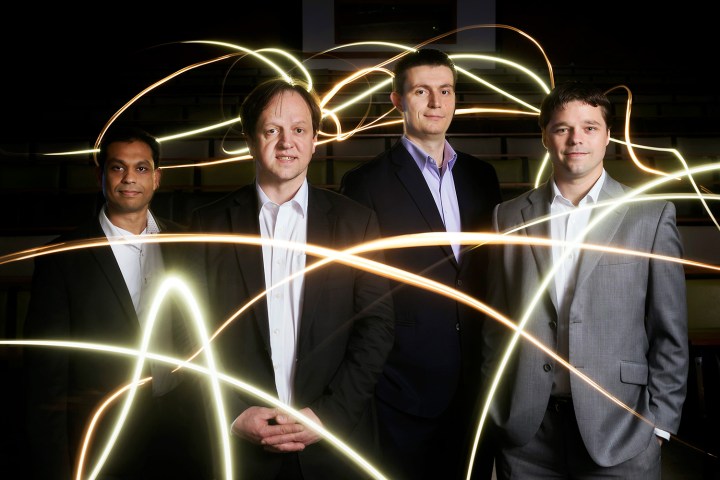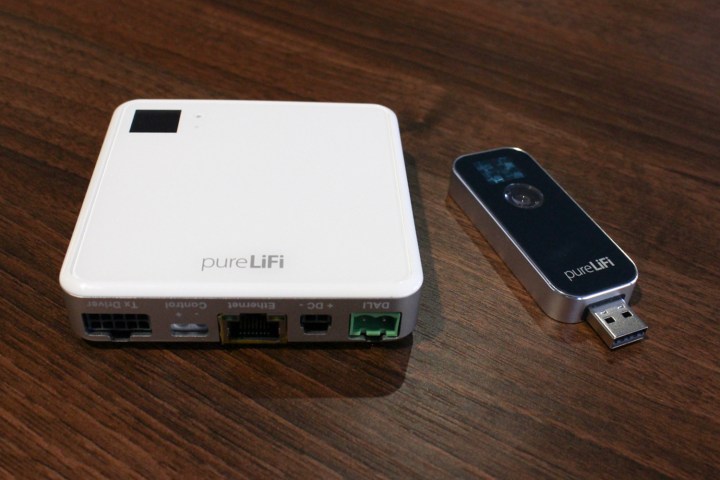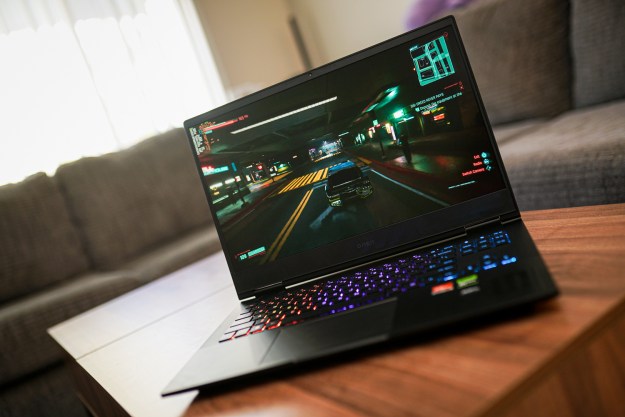
As demands grow, particularly video streaming, our cellular and Wi-Fi networks are being strained to breaking point. One possible solution to alleviating the strain is Li-Fi, an interesting technology that allows the internet to come through LED lights.
What is Li-Fi?
Li-Fi allows you to transmit data using light. While Wi-Fi relies upon radio frequencies to send data, Li-Fi employs infra-red and ultra-violet light, as well as visible light, to send data back and forth. With PureLiFi’s implementation, a router connects to an access point via Ethernet cable, the access point connects to a Li-Fi-enabled LED light and modulates the light at extremely high speeds. You plug a dongle with a transmitter and receiver into your laptop or tablet and it sends and receives data from and to the light. You can use it just the same way you would use Wi-Fi to surf the web, stream a video, or upload files.
We’ve been following the progress of Li-Fi for the last couple of years. After seeing a demonstration at MWC earlier this year, we gave Edinburgh-based PureLiFi our cool tech award. The team has been hard at work since then to miniaturize the technology and it recently took the wraps off a new product – the LiFi-XC.
New and improved LiFi-XC
Previous demonstrations relied on the LiFi-X, a chunky dongle produced as a proof of concept to allow potential customers to test the technology. The new LiFi-XC is much sleeker, with an aluminum casing and a stylish design that resembles a premium USB thumb drive.
“We’ve focused on the miniaturization, productization, and robustness of the technology,” PureLiFi Chief Operating Officer, Harald Burchardt, told Digital Trends. “We also substantially reduced the power draw of the dongle, which is particularly important as we move towards integration.”
“We’re looking at a two to three-year time frame to be able to integrate our technology into devices.”
The LiFi-XC system is comprised of the USB dongle, which plugs into a tablet or laptop, and an access point which connects a router to an LED bulb. It is the first fully certified Li-Fi system, with FCC, UL Listing, and CE approval. It’s designed to be plug-and-play and offers support for Windows, MacOS, and Linux.
We tried it out with a Microsoft Surface laptop and walked around the conference room of PureLiFi’s Edinburgh office while streaming a video. It worked flawlessly, offering speeds of 43 megabits per second (Mbps) up and down.
While LiFi-XC is a significant improvement over the original LiFi-X, the company is aiming to get the technology integrated into devices, in much the same way that Wi-Fi is integrated now.
“We were visited by the largest mobile manufacturers at MWC,” explains Burchardt. “We’re looking at a three-year time frame to be small enough for mass integration.”
If you strip away the casing, the board, receiver, and transmitter inside the LiFi-XC could be accommodated into a laptop today, maybe even a tablet. Further miniaturization will be needed before we see this technology in smartphones, but that’s what PureLiFi is working towards.
“Look at the path of LTE and Wi-Fi from dongle, to increased functionality, miniaturization, and lower power before it ended up in a product,” Alistair Banham, PureLiFi CEO, said. “This will follow the same path. We’re already developing new techniques to miniaturize and manage the way you collect photons.”
To that end, the company has hired another 30 people since the last time we spoke, taking the team up to 50. It’s an international mix that includes some of the best talent in the world. Little wonder then, that PureLiFi has tripled its revenue from last year and hopes to achieve similar growth in 2018.
Compelling use cases
Li-Fi offers some interesting advantages over Wi-Fi and cellular connections, which we’ll mention in a moment, but the main driver of adoption is the fast-growing burden on existing networks.
“Smartphones will need this technology to serve increasing demands.”
“Smartphones will need this technology to serve increasing demands,” Burchardt said.
There’s no doubt that we’re increasingly using smartphones and other mobile devices to access the internet. Global mobile data traffic grew 63 percent in 2016, according to Cisco, when 8 billion mobile devices each generated average traffic of 3.4GB per month. By 2021, it predicts there will be 11.6 billion mobile devices generating an average of 8GB of traffic per month.
“Li-Fi is a complementary technology,” Banham said. “The 5G framework is about using multiple bearers in a wireless environment to transfer data, that bearer could be light, it could be radio frequency (RF), it could be something else, so interoperability is all part of the 5G plan.”
Li-Fi offers around 1,000 times the data density that Wi-Fi can, enabling much more data per square meter. A single access point for each light is the ideal installation and will provide fast, reliable internet access, even in crowded situations.

There are security advantages as well. While Wi-Fi penetrates walls, light can be easily contained. Each Li-Fi enabled light has a unique IP address, so advanced geofencing is easy.
Some of PureLiFi’s early partners have been attracted by the lack of radio frequencies, which can interfere with equipment. Li-Fi can work well in environments like hospitals, power plants, and airplanes, because interference can be eliminated.
Earlier this year, PureLiFi teamed up with Nokia and Verizon to demonstrate the durability of Li-Fi in the aftermath of a simulated terrorist attack, in the shape of a simulated explosion in an underground tunnel in Georgia. RF often cuts out in these situations, making it impossible to maintain contact with first responders. Backup generators always focus on light first, so Li-Fi technology is a good fit, allowing people to communicate and locate each other in difficult circumstances.
A bright future
There are obviously some limitations to the technology right now, not least the fact you need the right hardware and the light to be on. Li-Fi increases the power needs of lights at a time when most of the industry is striving for greater power efficiency, but PureLiFi is already looking at how to reduce the power draw.
“We have the firm belief that Li-Fi will touch every aspect of our communications in the same way that Wi-Fi does now.”
Further miniaturization will also be vital as it looks to leave the dongle behind. PureLiFi is already working with OEMs on integration, though it won’t name them right now. It has also built partnerships with lighting manufacturers like Lucibel, Linmore LED, and Wipro to get the technology embedded into lights.
“We need a decent install base to serve devices for when smartphone integration comes,” Burchardt said.
The LiFi-XC is a clear step in the right direction and PureLiFi is working towards higher data rates using existing lighting structures and aiming for gigabit speeds in the long term. Li-Fi isn’t going to replace Wi-Fi any time soon, but it’s not aiming to – this is a complementary technology that can work in concert with existing networks to ensure we have seamless internet access all the time.
It may be a while before you see Li-Fi support in your home. For now, the LiFi-XC system is only for business partners, but PureLiFi is confident it will reach the consumer market in the next few years.
“We have the firm belief that Li-Fi will touch every aspect of our communications in the same way that Wi-Fi does now,” Burchardt said.
We’ll have to wait and see whether it can reach the heights of Wi-Fi, but looking at PureLiFi’s progress over the last year, we believe Li-Fi has a very bright future ahead of it.
Editors' Recommendations
- The key to fixing your bad Wi-Fi connection may finally be here
- 5G vs. Wi-Fi 6: Which is the future of wireless connectivity?




